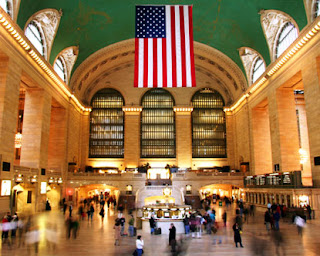What’s the Status of American Passenger Trains?
When was the last time you took the train in America? Any train… commuter or cross-country? If you’re in New York then it might have been yesterday on the Subway. But if you’re in any US location other than New York, Boston or Chicago then chances are that you don’t typically ride a commuter train and it’s also pretty likely that you have not recently taken a cross-country trip on our national train service Amtrak, if ever. We have great transit systems in locations that demand them. The point is that American passenger trains are not part of our culture today since there’s little demand and the only passenger train service we have is a national one. Our trains are used mainly for freight transportation.
It wasn’t always that way. Post 1950s real estate development in America is much to blame for our unfamiliarity with passenger trains. Urban sprawl, Levittown, shopping malls, cul-de-sacs, and the Eisenhower highway system have all contributed to our dependence on the car and taken us off our feet. It’s such a shame we’re off our feet for many reasons that I won’t get into here since I want to stay on point but, remember also that the post 1950s consumer unfortunately wanted urban sprawl. The good news is that today, we’re yearning to return to beautiful architecture and a sense of place and in turn, many municipalities across the United States are trying to renew and rehabilitate their down-towns and create walkable, mixed-use, pedestrian friendly places where we don’t need cars. So then how do people living in urban and walkable communities move around without a car? In theory: by train (or other transit/bicycle). I say ‘in theory’ because the idea of a walkable, mixed use community is that we not only gain a sense of place but we also move around by train (or other transit/bicycle). But private developers have not yet built train systems because there is just not enough demand for them yet to be profitable. American consumers need to show that they want to ride on trains. And it’s certainly not up to the government to provide a train system just because the private sector won’t touch it. I am aware however that for example the NYC subway is government owned but I am also aware that its losses are in the millions each year. We do not currently have a train culture because consumers don’t demand it and the private sector won’t touch it.
I’d like to see that change. I’d love for America to have a train culture. For CCS Architecture and Interior Design it would me tremendous opportunity to design and build beautiful architecture sited in wonderful mixed-use, pedestrian communities. It’s a challenge for us to pursue projects in an environment where asphalt parking lots and single-use zoning are the norm. People shouldn’t live that way…it denigrates our sense of place and forces us into our cars.
Consumers need to ask for train transit. Our patterns of American real estate development need to change throughout the whole country and until we stop building lousy, over-scaled housing in the suburbs, strip malls surrounded by asphalt and other single use buildings, then we will not have any use for the passenger train. If that time ever comes when in fact we demand to ride on a train across town or across country then those trains should not be a provision of the Federal Government but be provided to us by private enterprises. While I’m ecstatic to see efforts to spur high speed-train development in America, I am not pleased that those efforts have come from the government and not private enterprise. Billions of 2009 ARRA stimulus money, $8B actually, has been allocated to various states: $2.6B for a Tampa Orlando line in Florida, $1.25B for Tampa to Miami in Florida, $1.1B for Chicago, IL to St. Louis, MO, $810M to Wisconsin, $2.2B to California….and critics say the $8B is not nearly enough. Wake up people! Transportation does not drive development nor does government transportation spending. Free markets drive real estate development which in turn demands transportation on an as-needed basis. Don’t build and expect them to come. Wait for them to ask and then build. That’s how you make a profit.
The status of American passenger trains is bad. We don’t use them (yet) and we don’t manufacture them (yet) because we have no demand. But the good news is that Americans are asking for mixed-use, walkable communities and when the day comes that this demand is nationwide and not isolated, and then American private enterprises should step-in and build the tracks and rail-cars. And yes, they should profit from their private enterprise in particular because they should be rewarded for their efficiency and their risk. We all know that private companies run on efficiency and government does not. It’s so sad that the Chinese of all people have been bidding on our own Californian contracts to provide the rail tracks and cars on our west coast. That’s just awful. Transportation does not drive development and nor does government transportation spending. I really yearn for the day when we ask for passenger trains again because it will mean that the days of lousy, over-scaled housing in the suburbs, strip malls surrounded by asphalt and other single use buildings are OVER.
Best wishes,
CCS Architect
Visit our website www.ccsarchenter.com for more information about CCS Architecture and Interior Design and visit our blog to read this post at http://ccsarchenter.blogspot.com
Also follow CCS on twitter http://twitter.com/CCSArchitect
Photo from destination360.com on 10-2-2010


Comments
Post a Comment